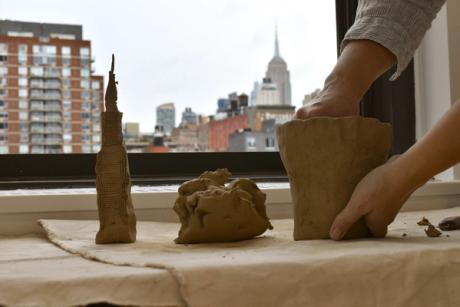
Taking a ceramics class at Greenwich House Pottery (GHP) is cheaper than going to a therapist—and, for many devotees to clay, more restorative. But securing one of the 400 spots per term at the 122-year-old institution in New York’s Greenwich Village has become increasingly difficult. In the last five years, GHP—which used to have to scale back offerings for lack of demand—has had waiting lists regularly ballooning to 140 people.“There’s just an explosion of people working in clay or wanting to,” says Fabio J. Fernández, the director of GHP, which offers classes, an artist residency programme and exhibition space at 16 Jones Street. Almost everyone in the US ceramics world has passed through its doors at one time as a teacher, resident or student, including Peter Voulkos, Toshiko Takaezu, Betty Woodman, David Salle, Simone Leigh and Kathy Butterly.An alternative to swiping screensFernández attributes the recent surge of interest to the art world’s embrace of the once-marginalised medium and a broader wellness trend that began before Covid-19. “People want a community and they want to make things with their hands rather than swipe the screen all day,” he says.On 19 February, GHP opens a 5,000 sq. ft annex in a 1928 Art Deco building at the corner of 14th Street and Eighth Avenue. The sixth-floor purpose-built space, with expansive views of Chelsea, can accommodate 270 additional students per term in its two classrooms for wheel throwing and hand building with three electric kilns.“We designed it exactly as we wanted, which is such a departure from living in the very charming but deferred maintenance of 16 Jones Street,” says Fernández, who worked with Ogawa Depardon Architects on a buildout funded almost entirely by the landlord, keen to rent vacant office space.In tandem, Fernández is leading a $7m capital campaign to modernise and expand GHP’s 1928 Colonial Revival townhouse on Jones Street. The phased renovations, also designed by Ogawa Depardon, will include a new rooftop classroom for another 50 students and renovated basement space for staff, the addition of an elevator and other accessibility improvements and the restoration of its backyard garden for community use and events.Founded in 1902 by the progressive social worker Mary Simkhovitch to help immigrants acclimatise to New York, Greenwich House comprises the pottery school, a music school, a nursery school, a methadone treatment clinic and four senior citizen centres. In the 1940s, the pottery school moved into the building at 16 Jones Street, which was originally constructed as a trade school for stone carvers.Prominent resident artistsIllustrious students included Lee Krasner and Jackson Pollock, the latter of whom worked there as a janitor to offset the cost of classes. In recent years, GHP has courted prominent contemporary artists, some without a background in clay, including Rirkrit Tiravanija and Ghada Amer, to its residency programme offering one to two months of studio space and technical assistance to five artists per year (Amer has continued in ceramics).While restrictions in Manhattan preclude gas kilns at the Chelsea annex, 16 Jones Street’s gas kilns predate those restrictions; the older facility also offers slip casting, wheel throwing and hand building. A pallet of raw clays is delivered weekly, with staff formulating them, not unlike an industrial bakery, into clay bodies that are hoisted throughout the building in buckets weighing up to 136kg via an exterior dumb waiter (underscoring the need for an elevator). GHP also mixes all its own glazes in a chemistry lab. “We’re keeping these skill sets alive,” Fernández says.He estimates that 20% of students are professionally trained artists and the others are a diverse mix of hobbyists—lawyers, architects, emergency room doctors, curators, retired teachers and more. Around 10% are over the age of 85; some have been coming for decades.“You could be sitting next to someone who is an advanced maker but the nice thing is there’s very little judgement,” he says of the GHP community. “You’re all in the room making things.”


























